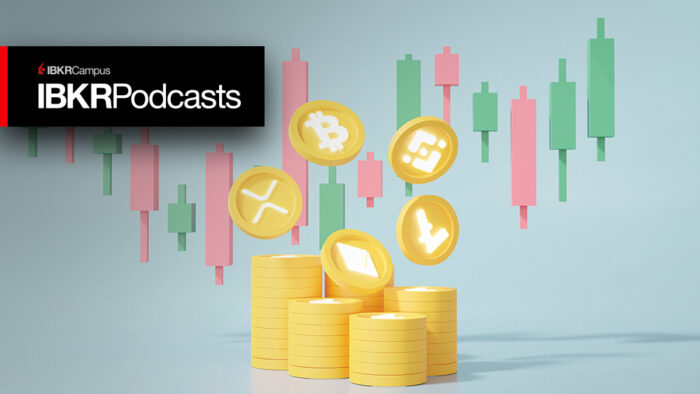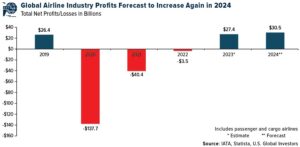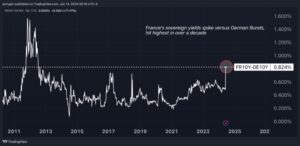Key takeaways
The Federal Reserve
Recent data indicates the US economy has been cooling modestly and disinflationary progress has resumed, which should help hasten the start of rate cuts.
Cash on the sidelines
There is a significant amount of cash that is likely to start moving to stock and bonds once the start of rate cuts appears imminent.
Earnings season
We needed to see a solid earnings season in the first quarter in order to provide a foundation for stocks to move higher. By and large, we got that.
Investors may be tempted to reduce exposure to equities right now. After all, major stock indices around the world, from the STOXX Europe 600 to the Dow Jones Industrial Average, have hit record highs in the last several weeks. And then there is the old adage “Sell in May and go away,” which suggests that investors should dump stocks during the summer and reinvest in the fall. I’m not a fan of seasonal investment strategies, and I don’t believe new market highs should necessarily be feared. Here are six reasons why I’m confident that stocks can move higher from here.
1. More signs suggest US disinflation is re-accelerating
In last week’s blog, I wrote that the most important data release last week would be the US Consumer Price Index (CPI) data for April. That’s because US disinflationary progress appeared to have stalled in the first quarter. The good news is that headline CPI was in line with expectations at 0.3% month-over-month and 3.4% year-over-year.1 More importantly, core CPI was 0.3% month-over-month and 3.6% year-over-year.1 The core CPI reading was the lowest since April 2021.1
And while at first blush the US Producer Price Index (PPI) for April seemed hotter than expected, a closer look indicated a benign print. Further, US retail sales came in lower than expected.
Taken together, this recent data indicates the US economy has been cooling modestly and disinflationary progress has resumed. This should help increase the Federal Reserve’s confidence that it will be appropriate to begin cutting rates soon. And lower rates could push equities higher. Historically, in the 12 months following the start of the last seven Fed rate cut cycles, global stocks, as represented by the MSCI All Country World Index, have risen on average more than 6%.2 And if we were to strip out the rate cut cycle that began in 2007 as the Global Financial Crisis was just beginning, the average return for the MSCI All Country World Index is more than 10%.2
2. Earnings season featured largely positive results
We needed to see a solid earnings season in the first quarter in order to provide a solid foundation for stocks to move higher. And by and large, we got that.
- For the first quarter of 2024, with 93% of S&P 500 companies reporting actual results, a whopping 78% of those companies have beaten earnings expectations and 60% of those companies have beaten revenue expectations.3
- Of the STOXX 600 companies that have reported first-quarter earnings to date, 60.7% beat estimates, versus the average quarterly 54% beat rate.4
- Small caps also experienced a positive earnings season. Of the 1,621 companies in the Russell 2000 that have reported earnings to date for the first quarter, 59.5% reported beating expectations.4
3. Stock buybacks are on the rise globally
As I’ve mentioned before, stock buybacks are on the rise in many parts of the world. For example, just a few weeks ago, Apple announced plans to buy back $110 billion in stock. And European and UK companies have significantly increased their stock buybacks, with their buyback yields now at levels seen in the United States. A 2021 study from Vanderbilt University Owings School of Business looked at 17 years of stock buyback activity and concluded that, beyond helping to increase share prices, stock buybacks also increased liquidity and lowered volatility.5
4. Valuations are attractive for many equities around the world
Yes, some US stocks sport high valuations — although most of the high valuation “Magnificent 7” type stocks are arguably supported by high expected earnings growth — but many equities around the world have low valuations relative to their historical ranges. For example, Chinese equities are very attractively valued — they are currently at the very low end of their long-term cyclically adjusted price-to-earnings ratio (CAPE) range. And Japanese, emerging markets, European, and UK equities are all at or below their 10-year average CAPE.6
While valuations are rarely predictive of outperformance in the short term, in general low valuation stocks have often realized upside potential with a catalyst or catalysts such as better-than-expected earnings or some form of policy support. In other words, low valuations and positive surprise can be a powerful combination. I believe it is likely that non-US stocks and smaller-cap stocks may perform better as rate cuts unfold and we near a global economic re-acceleration.
5. Cash is sitting on the sidelines
As I have said before, there is a significant overweighting to cash on the part of some investors, both retail and institutional. That excess cash sitting on the sidelines is likely to start moving to fixed income and equities once the start of rate cuts appears imminent. This could be a powerful catalyst for equities.
As a reminder, US money market assets peaked in the fourth quarter of 2008 before dropping significantly. It seems no coincidence that cash moved off the sidelines just as stocks began a strong and lengthy rally in March of 2009.7
6. Geopolitical tensions haven’t derailed stocks yet
It seems that geopolitical risks have multiplied in the past several years. However, investors seem to be reacting to geopolitical risks not by eschewing risk assets such as equities but by including perceived geopolitical risk hedges such as gold in their portfolios. The use of geopolitical risk hedges seems to have enabled investors to be comfortable maintaining exposure to equities. In fact, gold hit a new record high on May 20, likely helped by news of a Houthi attack on an oil tanker over the weekend as well as the death of the president of Iran in a helicopter crash, either of which could add to tensions in the Middle East. But that does not seem to be dragging down stocks.
Risks to watch
While positive on equities, I recognize that there are certainly risks to watch this year. I think we could certainly experience one or more stock market pullbacks this year as expectations around monetary policy can change very quickly. That’s OK and could be healthy as it may present entry points to add to equity exposure. I do suspect that we are close to the start of a sustainable broadening of stock market participation. I hope this serves as a reminder to revisit stock portfolio weightings to ensure adequate exposure to small-cap and non-US equities.
The week ahead
Looking ahead, we will be getting a lot of “Fed speak,” and I expect it to be rather hawkish as the Fed tries to keep a lid on easing financial conditions. We will be getting some other central bank speak as well, but I expect that to be more dovish as a rate cut from the European Central Bank in June seems to be a fait accompli — and there remains a good chance other central banks also begin to cut soon.
The most important data release, in my opinion, will be US Personal Consumption Expenditures Index at the end of May. This will help paint a picture for the Fed about disinflationary progress in the second quarter and could bring us meaningfully closer to the start of rate cuts. However, this week I will also be paying attention to inflation prints for the UK, Canada, and Japan as well as Purchasing Managers’ Index readings for the eurozone, UK, and US. After all, it’s all about the balancing act between lowering inflation without snuffing out economic growth. Rounding out the week will be several central bank decisions, the Federal Open Market Committee minutes, and of course my beloved Michigan Survey of Consumers, which is “must read” material on Friday.
Dates to watch
| Date | Report | What it tells us |
|---|---|---|
| May 20 | Reserve Bank of Australia meeting minutes | Gives further insight into the central bank’s decision-making process. |
| May 21 | European Central Bank President Lagarde speaks | Gives further insight into the central bank’s decision-making process. |
| Canada Consumer Price Index | Tracks the path of inflation. | |
| Bank of England Governor Bailey speaks | Gives further insight into the central bank’s decision-making process. | |
| Reserve Bank of New Zealand monetary policy decision | Reveals the latest decision on the path of interest rates. | |
| May 22 | UK Consumer Price Index | Tracks the path of inflation. |
| UK Producer Price Index | Tracks the path of inflation. | |
| European Central Bank President Lagarde speaks | Gives further insight into the central bank’s decision-making process. | |
| US Existing Home Sales | Indicates the health of the housing market. | |
| Federal Open Market Committee meeting minutes | Gives further insight into the central bank’s decision-making process. | |
| Japan Purchasing Managers Index | Indicates the economic health of the manufacturing and services sectors. | |
| Bank of Korea monetary policy decision | Reveals the latest decision on the path of interest rates. | |
| May 23 | Germany Manufacturing and Services Purchasing Managers Index | Indicates the economic health of the manufacturing and services sectors. |
| Eurozone Manufacturing and Services Purchasing Managers Index | Indicates the economic health of the manufacturing and services sectors. | |
| UK Manufacturing and Services Purchasing Managers Index | Indicates the economic health of the manufacturing and services sectors. | |
| Mexico Gross Domestic Product | Measures a region’s economic activity. | |
| US Manufacturing and Services Purchasing Managers Index | Indicates the economic health of the manufacturing and services sectors. | |
| US New Home Sales | Indicates the health of the housing market. | |
| UK GfK Consumer Confidence | Tracks UK consumers’ views of their finances and the economy. | |
| Japan National Consumer Price Index | Tracks the path of inflation. | |
| May 24 | UK Retail Sales | Measures consumer demand. |
| Germany Gross Domestic Product | Measures a region’s economic activity. | |
| US Durable Goods Orders | Tracks new orders placed with manufacturers for long-lasting goods. | |
| Canada Retail Sales | Measures consumer demand. | |
| University of Michigan Survey of Consumers (final) | Assesses US consumers’ expectations for the economy and their personal spending. |
—
Originally Posted May 21, 2024
Don’t sell in May and go away: Why stocks have room to run by Invesco US
Footnotes
- Source: US Bureau of Labor Statistics, as of May 15, 2024
- Source: Bloomberg, L.P. The starts of the last seven Fed rate cut cycles were June 9, 1989; July 7, 1995; Sept. 29, 1998; Jan. 5, 2001; Sept. 21, 2007; Aug. 2, 2019; March 6, 2020.
- Source: Factset Earnings Insight, May 17, 2024
- Source: LSEG I/B/E/S, as of May 14, 2024
- Source: Center for Capital Markets Competitiveness, “Corporate Liquidity Provision and Share Repurchase Programs,” by Craig M. Lewis and Joshua T. White, Vanderbilt University, Sept. 24, 2021
- Sources: LSEG Datastream and Invesco Global Market Strategy Office. Asset classes represented by the MSCI China, MSCI Japan, MSCI Emerging Markets, MSCI Europe, and MSCI UK indexes.
- Source: Board of Governors of the Federal Reserve System through Dec. 31, 2023, as of March 7, 2024
Important information
NA3593754
Image: deberarr / Getty
All investing involves risk, including the risk of loss.
Past performance does not guarantee future results.
Investments cannot be made directly in an index.
This does not constitute a recommendation of any investment strategy or product for a particular investor. Investors should consult a financial professional before making any investment decisions.
In general, stock values fluctuate, sometimes widely, in response to activities specific to the company as well as general market, economic and political conditions.
The risks of investing in securities of foreign issuers, including emerging market issuers, can include fluctuations in foreign currencies, political and economic instability, and foreign taxation issues.
Investments in companies located or operating in Greater China are subject to the following risks: nationalization, expropriation, or confiscation of property, difficulty in obtaining and/or enforcing judgments, alteration or discontinuation of economic reforms, military conflicts, and China’s dependency on the economies of other Asian countries, many of which are developing countries.
Stocks of small and mid-sized companies tend to be more vulnerable to adverse developments, may be more volatile, and may be illiquid or restricted as to resale.
Disinflation, a slowing in the rate of price inflation, describes instances when the inflation rate has reduced marginally over the short term.
The STOXX® Europe 600 Index represents large, mid and small capitalization companies across 17 countries of the European region
The Russell 2000® Index, a trademark/service mark of the Frank Russell Co.®, is an unmanaged index considered representative of small-cap stocks.
The Dow Jones Industrial Average is a price-weighted index of the 30 largest, most widely held stocks traded on the New York Stock Exchange.
The MSCI All Country World Index is an unmanaged index considered representative of large- and mid-cap stocks across developed and emerging markets.
The MSCI China Index captures large- and mid-cap representation across China H shares, B shares, Red chips, P chips and foreign listings (e.g. ADRs).
The MSCI Emerging Markets Index captures large- and mid-cap representation across 26 emerging markets countries.
The MSCI Europe Index captures large and mid-cap representation across 15 developed markets countries in Europe.
The MSCI Japan Index measures the performance of the large- and mid-cap segments of the Japanese market.
The MSCI United Kingdom Index is designed to measure the performance of the large- and mid-cap segments of the UK market.
The Consumer Price Index (CPI) measures change in consumer prices.
The Producer Price Index (PPI) is compiled by the Bureau of Labor Statistics and measures the average change over time in the selling prices received by domestic producers for their output.
Core inflation excludes food and energy prices, while headline inflation includes them.
The cyclically adjusted price-earnings (P/E) ratio is a valuation measure calculated using real per-share earnings over a 10-year period.
Fluctuations in the price of gold and precious metals may affect the profitability of companies in the gold and precious metals sector. Changes in the political or economic conditions of countries where companies in the gold and precious metals sector are located may have a direct effect on the price of gold and precious metals.
Personal consumption expenditures (PCE), or the PCE Index, measures price changes in consumer goods and services. Expenditures included in the index are actual U.S. household expenditures.
Purchasing Managers’ Indexes, or PMI, are commonly cited indicators of the manufacturing and services sectors’ economic health.
The Federal Open Market Committee (FOMC) is a 12-member committee of the Federal Reserve Board that meets regularly to set monetary policy, including the interest rates that are charged to banks.
The Survey of Consumers is a monthly telephone survey conducted by the University of Michigan that provides indexes of consumer sentiment and inflation expectations.
The Magnificent Seven stocks refer to Amazon, Apple, Alphabet, Meta, Microsoft, Nvidia, and Tesla.
The opinions referenced above are those of the author as of May 20, 2024. These comments should not be construed as recommendations, but as an illustration of broader themes. Forward-looking statements are not guarantees of future results. They involve risks, uncertainties and assumptions; there can be no assurance that actual results will not differ materially from expectations.
Join The Conversation
If you have a general question, it may already be covered in our FAQs. If you have an account-specific question or concern, please reach out to Client Services.
Leave a Reply
Disclosure: Invesco US
This does not constitute a recommendation of any investment strategy or product for a particular investor. Investors should consult a financial advisor/financial consultant before making any investment decisions. Invesco does not provide tax advice. The tax information contained herein is general and is not exhaustive by nature. Federal and state tax laws are complex and constantly changing. Investors should always consult their own legal or tax professional for information concerning their individual situation. The opinions expressed are those of the authors, are based on current market conditions and are subject to change without notice. These opinions may differ from those of other Invesco investment professionals.
NOT FDIC INSURED
MAY LOSE VALUE
NO BANK GUARANTEE
All data provided by Invesco unless otherwise noted.
Invesco Distributors, Inc. is the US distributor for Invesco Ltd.’s Retail Products and Collective Trust Funds. Institutional Separate Accounts and Separately Managed Accounts are offered by affiliated investment advisers, which provide investment advisory services and do not sell securities. These firms, like Invesco Distributors, Inc., are indirect, wholly owned subsidiaries of Invesco Ltd.
©2024 Invesco Ltd. All rights reserved.
Disclosure: Interactive Brokers
Information posted on IBKR Campus that is provided by third-parties does NOT constitute a recommendation that you should contract for the services of that third party. Third-party participants who contribute to IBKR Campus are independent of Interactive Brokers and Interactive Brokers does not make any representations or warranties concerning the services offered, their past or future performance, or the accuracy of the information provided by the third party. Past performance is no guarantee of future results.
This material is from Invesco US and is being posted with its permission. The views expressed in this material are solely those of the author and/or Invesco US and Interactive Brokers is not endorsing or recommending any investment or trading discussed in the material. This material is not and should not be construed as an offer to buy or sell any security. It should not be construed as research or investment advice or a recommendation to buy, sell or hold any security or commodity. This material does not and is not intended to take into account the particular financial conditions, investment objectives or requirements of individual customers. Before acting on this material, you should consider whether it is suitable for your particular circumstances and, as necessary, seek professional advice.































stocks are at same levels when 5 rate cuts were expected.. does not make much sense.. adjusted for inflation many earnings are not keeping up.